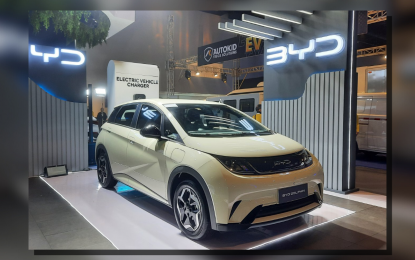
EV GROWTH. An electric vehicle is showcased at the 11th Philippine Electric Vehicle Summit at the SMX Convention Center in Pasay City on Thursday (Oct. 19, 2023). The Electric Vehicle Association of the Philippines targets e-vehicle sales to reach the 6.6-million mark by 2030. (PNA photo by Kris Crismundo)
MANILA – The Electric Vehicle Association of the Philippines (EVAP) on Thursday projected that cumulative sales of e-vehicle in the country would reach 6.6 million units by 2030.
The EVAP announced this outlook at the opening of the 11th Philippine Electric Vehicle Summit at the SMX Convention Center in Pasay City.
The industry association is banking on the implementation of government policies that will hasten the development of the local e-vehicle sector, especially manufacturing and establishing necessary infrastructure like charging stations.
On the sidelines of the event, EVAP chairman emeritus Ferdinand Raquelsantos told reporters that of the cumulative 6.6-million-unit sales outlook by 2030, more than half of the e-vehicles will still be two-wheeled vehicles.
Raquelsantos said at least 60 percent of the e-vehicles in the country are two-wheeled vehicles.
EVAP president Edmund Araga said the group is banking on the government’s support to stimulate the growth of the local industry.
“Our partner, the Department of Energy (DOE), is actively pushing for a faster roll out of EV use nationwide under its Comprehensive Roadmap for the Electric Vehicle Industry or CREVI, which is serving as our ‘north star’ for wider and more concise implementation of the EVIDA (Electric Vehicle Industry Development Act) Law,” Araga said.
Araga said Executive Order (EO) 12, which scraps tariff rates of completely built-up imported e-vehicles for five years, is helping e-vehicles to be more cost competitive in the Philippines.
The EVAP also welcomes the exemption of e-vehicles from excise tax and slashing 50 percent of excise tax for hybrid vehicles under the Tax Reform for Acceleration and Inclusion Law.
DOE Secretary Raphael Lotilla said in his keynote speech that the agency has proposed the temporary removal of tariffs on import duties on electric motorcycles like e-vehicles applied in hybrids and hybrid e-vehicles as well as their parts and components.
“By eliminating the tariff rates for these items, we can provide consumers in both private and public sectors with greater opportunities to choose EVs over traditional vehicles. We are now awaiting feedback from the Tariff Commission on this proposal,” Lotilla said.
He added this would help the targets under the CREVI to achieve a minimum 10-percent e-vehicle share for all sectors, excluding trucks, by 2040 under the Business-As-Usual Scenario, and setting a more ambitious target of 50 percent of all fleets by 2040 under the Clean Energy Scenario.
“These shall be achieved through various initiatives such as a phased approach to improve EV utilization, promotion of EV manufacturing, EV research and development, human resource development and improving relevant policies and credit programs,” the DOE chief said.
More perks
The EVAP executives said that aside from eliminating tariff rates for imported e-vehicles, the government should focus its policies on providing incentives that will stimulate the local manufacturing of e-vehicles and its parts and components.
Raquelsantos said the Department of Trade and Industry is eyeing a Comprehensive Automotive Resurgence Strategy-like program for e-vehicle manufacturing here that will give subsidy for every e-vehicle unit that will be produced locally.
Such subsidy will be under the Electric Vehicle Incentive Strategy. (PNA)
